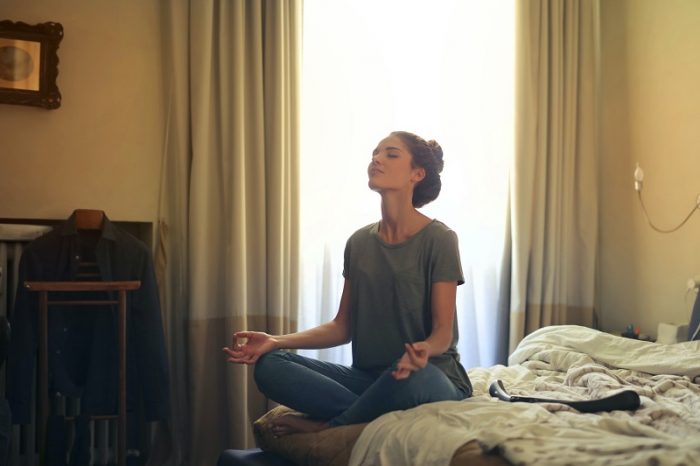Check out Elephant’s Continually-updating Coronavirus Diary. ~ Waylon
~
“There’s a center of quietness within which has to be known and held. If you lose that center, you are in tension and begin to fall apart.” ~ Joseph Campbell, The Power of Myth
~
In my office, there is a picture that habitually hangs askew.
People often notice that it is off center. Some, including one of my colleagues, cannot help themselves: they walk over and straighten it.
I rarely do, and have wondered why.
When we are centered internally, the outer world does not affect us quite so much. Losing and finding center is a perfect metaphor for our current world, and all that takes us off center, including fear, anxiety, and overwhelm.
Social distancing can be lonely, and loneliness may trigger biochemical cravings akin to hunger. This is the perfect storm for a quick, but unhealthy fix. While you may be tempted to numb these feelings with food, alcohol, or another addiction, there are better ways.
What is center?
What does center feel like? While it’s different for everyone, for me “center” is stillness, calm, balance, breath—an embodied experience of these traits.
Center lives within the body. When centered, I am aware of an openness within my chest, and I feel expansive. I can sense the stability of my feet on the floor. Lack of center, on the other hand, feels chaotic, scattered, and as if I am out of balance. My body feels tense, my chest and neck tight. I sometimes notice that I am not aware of what’s in my environment or don’t feel connected with myself. When these imbalances happen, I tend to be more anxious, self-critical, or overwhelmed.
Another thing that I’ve found helpful is the idea that center is present, rather than future, focused. I’m attending to the feeling of myself in my space now, not a month or year from now. For that reason, it’s almost impossible for anxiety and center to coexist.
Spiritual traditions and centering
While centering is a secular practice, I find it deeply spiritual. One of the reasons is that while centering encourages connection within one’s self, that sense of connection often feels much deeper and more expansive.
When we think of centering we often think of mindfulness. Mindfulness is the process of focusing on the present moment, often by observing the breath. During mindfulness meditation, many different kinds of thoughts, feelings, and bodily sensations arise. Mindfulness practice involves allowing such thoughts, feelings, and sensations to come up and pass without judgment and while simply noticing. For me, it’s the ultimate way to practice non-judgmental awareness, stillness, and deliberate intention.
Mindfulness is a core tenet of Buddhism, where it is seen as a way to release “grasping.” Grasping is connected to pleasure seeking (including over-indulgence of food and alcohol), and concerns about self-image and self-judgments, as well as a need for possessions.
Other religious perspectives also have centering practices. This includes the Christian Centering Prayer, which encourages the the person offering the prayer to choose a sacred word or symbol that reflects God’s presence and action. The person offering the prayer repeats this word, with focused awareness on it.
Centering for troubled times
Centering is not a one-size-fits-all approach. Below are some centering practices that I have found useful. What’s common to all is approaching centering with non-judgmental awareness and compassion—great qualities to cultivate.
1. Center with earth connection. This is one of the most basic centering techniques, and a personal favorite. Centering with earth connection involves becoming aware of our literal physical connection to the earth.
Stand with your feet a comfortable distance (about shoulder’s length) apart, arms comfortable and loose. Relax your shoulders and keep your spine straight. Inhale deeply. Notice your feet on the floor, and how grounded you feel in your connection with the earth.
You may also notice other things, such as how lifting one foot may feel ungrounded or how by raising your arms overhead the additional space your body inhabits feels even better. For added grounding, you can picture yourself literally growing roots from your feet through to the ground, the ultimate experience of stability. In fact, just noticing these roots grounding you may be one way to address physical sensations of anxiety.
2. Center with breath. Wherever we are, and whatever the circumstance, our breath is a constant. Breath is a way to slow down and connect with your body.
There are many types of calming breaths. One technique I like is four-square breathing: breathe in deeply to a count of four, pause for four, breathe out for four, pause for four, and repeat. Another nice way to connect mind, body, and spirit using breath is to practice golden light breathing. Visualize a beautiful golden light surrounding you. Breathe in, visualizing the light filling your body. Breathe out fear, anxiety, or whatever you need to release.
3. Center with a word, phrase, or mantra. This is a powerful method of centering. Have you ever seen the old “Seinfeld” shtick “Serenity Now” in which Frank Costanza repeats this phrase every time he gets angry (with hilarious results)?
All chuckles aside, mantra meditation, the repetition of a word of phrase, is very calming. Sit in a comfortable seated position, and breathe in to connect with body and breath. Then, in your mind’s eye repeat your word or phrase, while still breathing. When I do this, I notice a gradual slowing and emptying of the clutter in my mind. Repeat the word or phrase as needed. Some examples are “Peace,” “Calm,” or “Quiet Within.” If you’re a visual person, visualize the letters in your mind’s eye as you repeat them.
4. Center with a walking meditation. Mindful walking is perfect for spring. Walking meditation was popularized by Zen leader and mindfulness author Thich Nhat Hanh.
It involves walking slowly and deliberately while attending to breath and movement. Try to take a breath and sync the breath with each step, feeling the connection as your foot touches the ground. A beautiful setting outdoors enhances the practice. You can also add a calming phrase while you walk, such as “I am home” or “I am at peace.”
5. Center by connecting with your heart self. This lovely practice is also known as Loving-Kindness meditation.
While sitting, breathe in deeply and connect with your body. Now focus on your heart chakra, placing your hands over your heart to increase connection. In your mind’s eye, see a lovely green lotus flower slowly opening as your chakra opens and expands. You can then offer loving-kindness to yourself, a loved one, your community, or all the world. Some phrases to do so are: “May I be filled with loving-kindness. May I be safe. May I be happy, and may I know my inner light.”
~


 Share on bsky
Share on bsky





Read 2 comments and reply